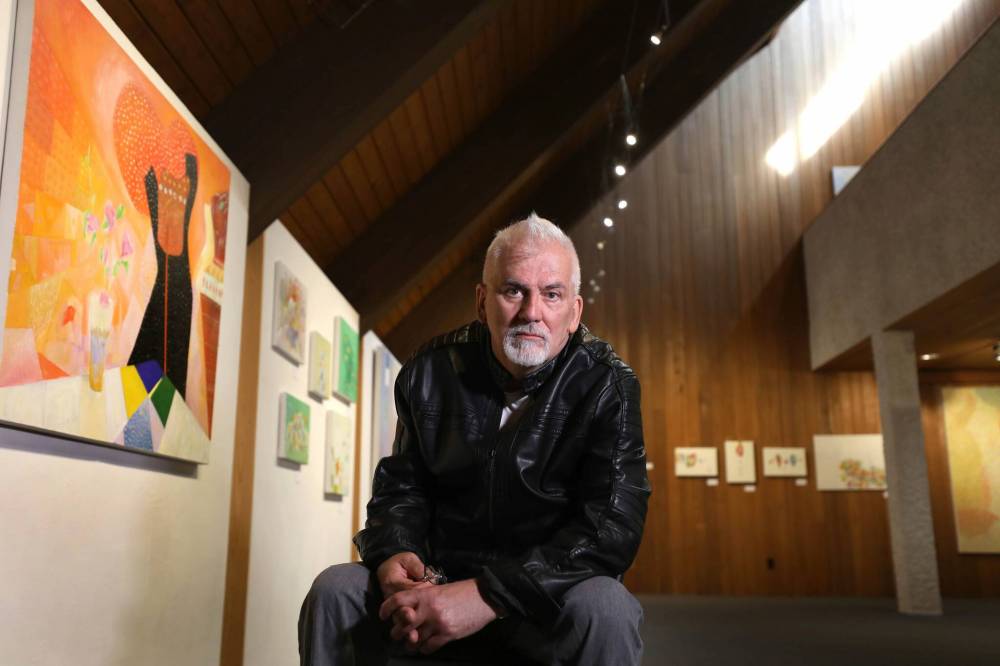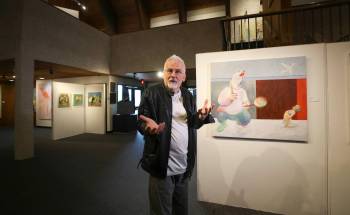Posing questions with paint and canvas ‘Art is a form of communication, a form which asks questions but never provides answers,’ says Milos Milidrag
Read this article for free:
or
Already have an account? Log in here »
To continue reading, please subscribe:
Monthly Digital Subscription
$0 for the first 4 weeks*
- Enjoy unlimited reading on winnipegfreepress.com
- Read the E-Edition, our digital replica newspaper
- Access News Break, our award-winning app
- Play interactive puzzles
*No charge for 4 weeks then price increases to the regular rate of $19.00 plus GST every four weeks. Offer available to new and qualified returning subscribers only. Cancel any time.
Monthly Digital Subscription
$4.75/week*
- Enjoy unlimited reading on winnipegfreepress.com
- Read the E-Edition, our digital replica newspaper
- Access News Break, our award-winning app
- Play interactive puzzles
*Billed as $19 plus GST every four weeks. Cancel any time.
To continue reading, please subscribe:
Add Free Press access to your Brandon Sun subscription for only an additional
$1 for the first 4 weeks*
*Your next subscription payment will increase by $1.00 and you will be charged $16.99 plus GST for four weeks. After four weeks, your payment will increase to $23.99 plus GST every four weeks.
Read unlimited articles for free today:
or
Already have an account? Log in here »
Hey there, time traveller!
This article was published 12/05/2022 (1307 days ago), so information in it may no longer be current.
Art preview
Who Am I? A Retrospective 1997-2022
By Milos Milidrag
● MHC Gallery, Canadian Mennonite University, 600 Shaftesbury Blvd.
● To June 18
● Monday-Friday, 8.30 a.m. to 4.30 p.m; Saturday noon to 5 p.m.
Like a sculptor who discovers a statue in stone and chips away to release it, artist Milos Milidrag sees a picture trapped within his canvas and sets off to free it with his paints.
“I am sculpting the canvas but dealing with two dimensions,” he says.

Milidrag “reads his canvas,” moving it around to better peer into it and only starts to paint when the picture emerges.
“I believe every piece of canvas already contains an image of what is going to be on it. I meditate and turn the canvas, trying to seek out the image and when I think I have found it, I start to paint with short strokes. If I am going in the right direction, then the process is easy, but if I am mistaken then I have a hard time and it becomes a battle between me and the canvas.”
Milidrag describes his style as “lyrical abstraction,” drawing a comparison to instrumental music.
“You have tones but you don’t have lyrics there,” he explains. It’s a form of expressionism he admits but woe betide anyone who tries to stick a label on his work.
“I don’t like labels. I don’t like determination. For me, as an artist if I put a label on it, if I put it in a box then it’s not freedom. And I enjoy freedom.”
In 1997 Milidrag and his family arrived in Canada from the former Yugoslavia as refugees, leaving behind everything familiar to escape the horrors of civil war. He became a Canadian citizen in 2001.

This year he celebrates 25 years as an artist in Canada with the exhibition Who Am I? A Retrospective 1997-2022 at MHC Gallery at the Canadian Mennonite University. This body of work addresses Milidrag’s search for answers after his arrival to North America as he grappled with life here after leaving his home. He says his art evolved to reflect the shift in his circumstances.
“My first works in fine art were very minimalist abstraction, like haiku. There was so much white, hardly any colour. But coming to Canada, my work started to change. The people here, they have six months of whiteness and they are starving for colour. So I started adding colours to my paintings and now my work is full of colours.”
The trauma of war is never far from his mind, and the current troubles in Ukraine have brought his memories to the fore. Milidrag feels for civilians who have found themselves caught up in a conflict they neither want nor support
“Of course I have strong feelings. My memories never go away,” he says. “My feelings are for ordinary people who are like myself. War should stop, of course peace is better than anything.
“And from my experience I can tell you, on both sides mothers cry the same. It doesn’t matter which side you are on, when a mother loses a child, they cry the same.”

Mothers and women are a recurring theme in a particular body of work, Forgotten Flowers, which he painted between 2014 to 2017 as an ode to women.
“Sometimes we forget how much women have to survive and how big a role they play in our lives. Women are stronger than men are and that’s my experience from the war; I saw women who were able to keep their families together. People always see men as ‘warriors’ but these men, they don’t care about keeping families together.”
Milidrag is looking forward to showing his works in a gallery again — the pandemic proved tough for him like for most and he especially missed the chance to converse with people.
“The pandemic hurt me a lot. You don’t have contact with others, with public and you can’t show work… I am not good with new media, and I think you can’t just enjoy the work by looking at the screen. It is better to come to the gallery and see the work for yourself.
“Doing art is very conversational, that is how I talk to people, via my art. Art is a form of communication, a form which asks questions but never provides answers. Art cannot change the world, but it can render it more beautiful and humane.”
The exhibition at MHC Gallery will showcase 65 of his paintings, including a number from his most recent work, Listening to Silence, that find him addressing the meaning of existence.

By turning away from the outside world and following his feelings, he says, he is reflecting his inner world.
“You will always be looking for answers, however long you live. But living here I have better conditions to search for answers. For me, doing art is the way to find the meaning of our existence in the world… to leave some kind of trace behind you that at one point in time you existed, that you didn’t waste your life.
“It’s not popular to reference him now but Dostoevsky was a genius and he said, ‘Everybody needs to build a house and if you can build a house, then make children, and if you can make children, then make art” and the best people do all that three things together; make house, make children, make art. And I think that is the meaning of our existence.”
Now in his 70s, Milidrag is as busy as ever. He cites Pablo Picasso as as his favourite artist — “If you look at his work from the beginning, he could do everything” — and says that even now, with such a prolific body of work, he still battles with doubt.
“Creating art is not always a joy… but most of the time I am successful,” Milidrag says. “But as an artist you always have doubt. Is what I am doing OK? Is it good? That kind of thinking will also help you. The only way to reach something is to try and do more and more and more.

“That’s my life and that’s what it looks like. I go to bed thinking about new paintings and I wake up thinking about art, and I will be doing my art until I can’t breathe.”
Twitter: @nuchablue

Our newsroom depends on a growing audience of readers to power our journalism. If you are not a paid reader, please consider becoming a subscriber.
Our newsroom depends on its audience of readers to power our journalism. Thank you for your support.







